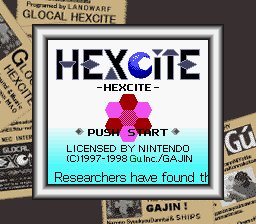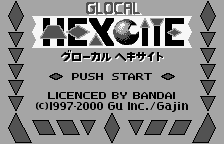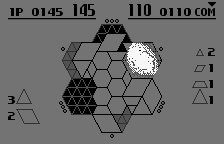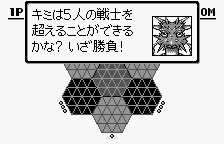Retro Replay Review
Gameplay
Hexcite: The Shapes of Victory is a deceptively simple puzzle game that unfolds on a compact, seven-hexagon honeycomb grid. Players begin by placing a geometric shape—be it a triangle, parallelogram, hexagon or other polyform—in the central cell. With each turn, the opponent (either CPU or a second person on the same system) must place a new shape adjacent to an existing piece, lining up a full side to keep the pattern unbroken. This turn-based mechanic makes each move count, as the choice of shape and placement can open up opportunities for bonus scoring or force an opponent into a trap.
(HEY YOU!! We hope you enjoy! We try not to run ads. So basically, this is a very expensive hobby running this site. Please consider joining us for updates, forums, and more. Network w/ us to make some cash or friends while retro gaming, and you can win some free retro games for posting. Okay, carry on 👍)
The scoring system is where the true strategy of Hexcite shines. Completing a full hexagon yields bonus points, but placing a shape so that it completes two sides of different hexagons at once grants an even larger reward. Skilled players will set up chains of near-completed hexes, baiting their opponent into a placement that hands over massive bonus potential. When the field is full—or when no remaining piece can fit—the game concludes, and points are tallied. Any unplayed shapes incur penalties based on complexity, with larger shapes like hexagons costing twice as much as triangles.
For those looking for local competition, Hexcite offers both same-system and link-cable play, allowing two players to go head-to-head without resorting to CPU opponents. This supports intense showdowns where each player can experiment with different shapes and tactics. The limited board size keeps matches brisk but tense, ensuring that no single game drags on too long. Whether you’re a casual puzzler or a competitive strategist, Hexcite’s turn-based design and varied polyomino pieces provide a deeply engaging mental workout.
Graphics
Visually, Hexcite: The Shapes of Victory embraces a clean, minimalist aesthetic that keeps the focus squarely on gameplay. The honeycomb grid is rendered in soft, contrasting hues, making each hexagon clearly distinguishable. Shapes are color-coded to help players quickly recognize which piece is which, eliminating any guesswork amidst heated moments of play. Overall, the palette is bright and inviting without ever feeling garish.
Animations are subtle yet satisfying: when a hexagon is completed, the cell pulses and briefly changes color, providing instant visual feedback that reinforces the reward. Even the simple sound effects—gentle clicks, a soft chime on bonus completion—serve to complement the action without overwhelming the senses. The interface remains uncluttered, with easily readable menus and shape selections that someone new to polyform puzzles can grasp in moments.
While there are no flashy 3D models or cinematic cutscenes, the graphical style fits Hexcite’s puzzle-centric identity. It’s a testament to thoughtful design when a game can remain visually appealing while deliberately avoiding unnecessary frills. The result is an experience that feels modern and polished, even though the core presentation is straightforward. Whether played on a PC or in its board game incarnation, the visuals always support the challenge rather than distract from it.
Story
Hexcite is not a narrative-driven blockbuster; instead, it offers an abstract premise rooted in geometric conquest. Players assume the role of master strategists vying to control the hex realm—an arena where shapes reign supreme. Though the game lacks a fully developed plot, it weaves a light thematic thread through brief text introductions and victory screens that celebrate your triumph in poetic, shape-inspired quips.
This minimal storytelling approach ensures that sessions remain focused on cerebral combat rather than lore-heavy exposition. There are hints of a greater hexagon hierarchy, with occasional background art depicting pyramid-like structures formed from smaller shapes, but these serve more as visual flavor than as a driving narrative. For puzzle aficionados who crave uninterrupted gameplay, this pared-back story design is a welcome choice.
Fans of board games might recall the Japanese tabletop version of Hexcite, complete with rulebook anecdotes about legendary shape-smiths and ancient honeycomb kingdoms. While the digital adaptation doesn’t delve deeply into that rich backstory, it does preserve the feel of an age-old competition. Each match feels like a small chapter in an ongoing saga of geometric supremacy, giving players a sense of purpose beyond simply filling the board.
Overall Experience
Hexcite: The Shapes of Victory is a masterclass in focused puzzle design. Its compact playing field and diverse roster of polyform pieces ensure that no two games feel the same. The intuitive ruleset allows newcomers to get moving in minutes, while the scoring nuances—double bonuses, penalty subtractions and hexagon completions—provide enough depth to satisfy strategy veterans. Matches remain brisk yet strategically rich, making Hexcite perfect for both quick sessions and extended tournaments.
The balance between single-player CPU challenges and local multiplayer elevates the game’s replay value. Whether sharpening your tactics against varying AI difficulty levels or engaging in tense duels against friends via split-screen or link-cable, each mode offers its own flavor of competitive fun. The subtle yet effective audio-visual presentation further enhances the experience by spotlighting gameplay over gimmicks.
While Hexcite does not lean heavily on narrative or flashy graphical flourishes, its core puzzle mechanics and minimalist design choices result in an engaging, mentally stimulating title. It’s a standout entry for anyone interested in abstract strategy games, offering a blend of approachable rules and deep tactical opportunities. If you’re seeking a title that rewards planning, foresight and a dash of cunning, Hexcite: The Shapes of Victory is sure to capture your imagination.
 Retro Replay Retro Replay gaming reviews, news, emulation, geek stuff and more!
Retro Replay Retro Replay gaming reviews, news, emulation, geek stuff and more!









Reviews
There are no reviews yet.